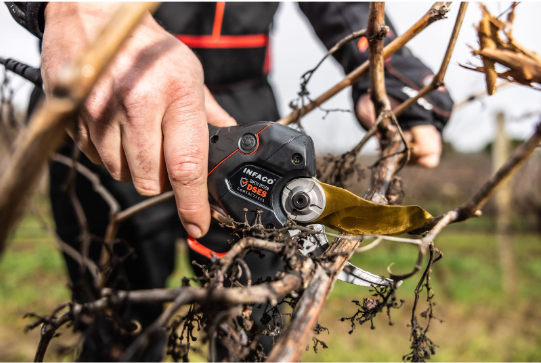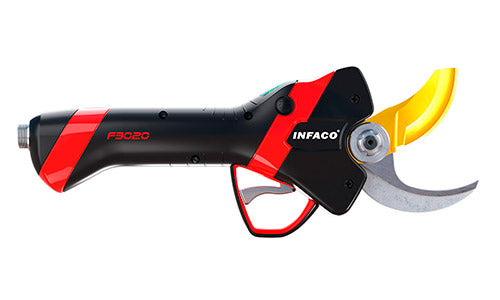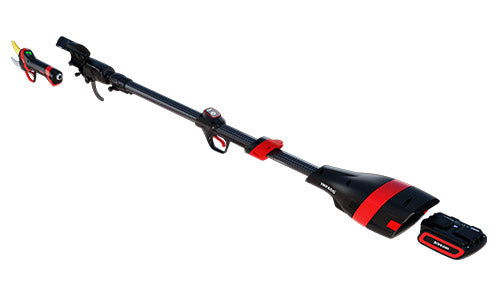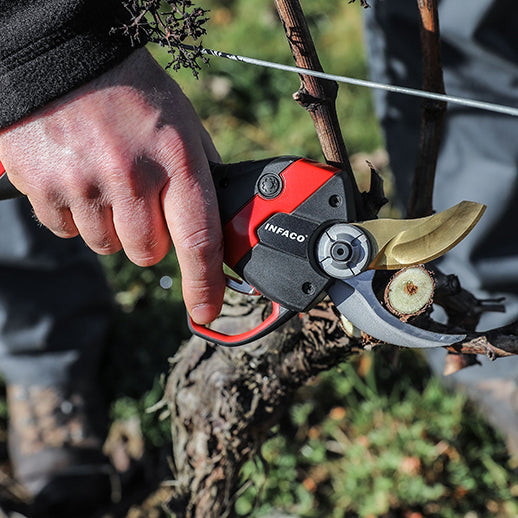Why it’s time to retire pneumatic tools and go electric

In today’s agriculture, every second, every cut, and every investment counts. For decades, pneumatic tools have been the go-to choice for pruning in vineyards and orchards. But the rise of electric pruning tools is changing that — fast.
If you're still using an air compressor and hose system to prune, it's time to consider why many American growers are upgrading. From improved ergonomics to reduced maintenance, electric is not just the future — it’s the smarter present.
Electric vs. Pneumatic: What's really different?
1. Setup and Portability
Pneumatic pruners require:
-
A portable or stationary air compressor
-
Hoses, couplings, oiling systems
-
Regular pressure adjustments
Electric pruning tools, like the INFACO F3020:
-
Are battery powered
-
Require no external hardware
-
Can be carried easily across steep, dense plots
That means fewer cables, less bulk, and faster deployment, especially in vineyards with varying terrain or remote orchard blocks.

2. Maintenance Requirements
Pneumatic systems have more failure points:
-
Oil residue buildup
-
Hose leaks
-
Moisture condensation
-
Valve sticking
Electric pruning tools, especially from brands like INFACO, require:
-
Occasional blade sharpening
-
Battery charge cycles
-
Periodic internal checkups (often once per season)
The difference? Pneumatic tools need daily oversight, whereas electric units can work day after day with minimal interruption.
3. Operator Safety and Comfort
Pneumatic tools are:
-
Louder (up to 90–100 dB near the compressor)
-
Heavier with hose drag
-
Risky in wet conditions due to metal corrosion
Electric pruners offer:
-
Quieter operation (50–60 dB)
-
No hose resistance
-
Lighter, more ergonomic handles
-
Sealed, moisture-resistant components
According to INFACO USA’s field data, growers report 50–70% less wrist fatigue using the F3020 compared to older pneumatic systems.
Cost comparison: Think total value, not just entry price
Let’s be transparent — electric pruning tools like the INFACO F3020 require a higher initial investment than basic pneumatic setups. But that’s only part of the story. When you compare total cost of ownership, time saved, and reduced maintenance, electric wins.
Initial Investment Snapshot
|
Cost Element |
Pneumatic Setup |
Electric (INFACO F3020) |
|
Pruner tool |
$500–700 |
$2,170 |
|
Compressor |
$1,000–3,000 |
Not needed |
|
Hoses, oilers, filters |
$150–300 |
Not needed |
|
Installation/setup |
$200+ (optional) |
None |
|
Total |
$1,850–4,200+ |
$2,170 |
But Here's the Catch: Running Costs Over Time
Pneumatic Systems:
-
Require daily oiling
-
Higher failure risk due to pressure leaks and moving parts
-
Hoses wear and need replacement ($50–200/year)
-
Compressors draw significant power or gas
Electric (F3020):
-
One battery = full workday
-
No hoses, compressors, or lubricants
-
Annual maintenance = simple and predictable
-
Fully modular design means faster, cheaper part replacements
Over 5 years, most INFACO users report 25–40% lower operational costs versus pneumatic systems, especially when factoring:
-
Tool downtime
-
Crew fatigue/injury
-
Transport complexity
Why it still pays off
While the upfront price tag of $2,170 may seem higher, the F3020 replaces multiple tools, reduces your maintenance headaches, and allows for modular add-ons (fencing, tying, harvesting, hoof trimming). That makes it not just the best electric pruning tool — but possibly the best farm tool investment medium-sized operations can make.
Performance in the field: What growers say
INFACO USA surveyed a group of vineyard and orchard managers across California, Oregon, and Texas.
Key findings:
-
85% said pruning speed improved after switching to electric
-
78% reported fewer injuries or muscle complaints
-
93% said tool prep and transport were faster and easier
-
All cited better comfort in cold or rainy conditions
Why more American growers are going electric
Battery technology has matured
Earlier electric tools couldn’t match pneumatic power — but the F3020 proves that’s no longer the case. With over 8 hours of real-world runtime, a single charge can power a full workday.
Modularity = More than pruning
The F3020 also supports:
-
Crimping heads (for fencing)
-
Different head sizes
It’s not just a pruner — it’s a platform. And that multi-functionality is unmatched in the pneumatic world.
Electric tools and crew management
Pneumatic systems often require:
-
Compressor setup at the start of every day
-
Crew briefings on air safety
-
Checking hose layout to avoid trip hazards
Electric pruning tools streamline this:
-
Hand tools can be issued like any other gear
-
Training time is cut in half thanks to simplified design
-
No large machinery needed for setup
For contractors or medium-sized farms hiring seasonal labor, electric makes onboarding easier and cuts ramp-up time by 50%.
FAQs: Electric vs Pneumatic Pruners
Q: Are electric tools powerful enough for mature wood?
Yes. The F3020 can cut up to 55 mm (1.57 in) with the Maxi head — comparable to heavy-duty pneumatic pruners.
Q: Is it safe to use electric pruners in rain or humid conditions?
Yes. INFACO tools are rated IP54, meaning dust- and splash-resistant — suitable for field conditions. However, while the tool itself is designed for harsh environments, we recommend protecting the battery pack under a waterproof jacket or vest during prolonged exposure to rain or when working in heavy downpours. This simple precaution helps extend the battery’s life, maintain full autonomy, and avoid potential moisture-related issues.
Q: What about tool longevity?
With proper maintenance, electric pruners last 7–10 years. The F3020 includes modular parts that are easily replaced.
Q: Do I need multiple batteries?
A single battery can last up to 10 hours. For intensive or double-shift use, most pros opt for a backup battery.
Time to ditch the compressor
The age of air hoses and daily oiling is ending. Today’s best farms are powered by electric pruning tools that work smarter, faster, and cleaner.
Switching to the INFACO F3020 isn’t just about following a trend. It’s about:
-
Cutting overhead
-
Reducing operator fatigue
-
Increasing ROI
-
Future-proofing your farm equipment
Ready to move forward?
Book a demo near you or Talk to a local dealer to compare hands-on.









